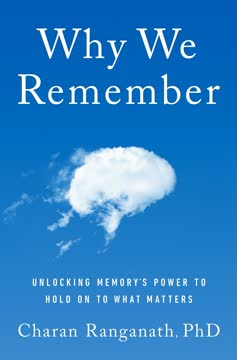Key Takeaways
1. Stress and loss of control drive people towards misbelief
Stress is cumulative, and the research by Hebel-Sela and her colleagues made it clear that the source of stress does not have to be directly related to the content of the misbelief for it to shape a person's thinking about that topic.
Unpredictable stress is particularly damaging to our cognitive abilities and decision-making processes. Unlike predictable stressors (like taxes or exams), unpredictable stress (such as sudden job loss or a global pandemic) creates a feeling of helplessness. This loss of control drives people to seek explanations and someone to blame, making them more susceptible to misbelief.
Research shows that:
- Stress reduces cognitive bandwidth and executive control
- People under stress are more likely to see patterns where none exist
- Feeling out of control increases the likelihood of adopting conspiracy theories
To combat this:
- Practice stress-reduction techniques
- Focus on areas of life where you do have control
- Seek social support to buffer against stress
2. Cognitive biases shape our perception of reality
It ain't what you don't know that gets you into trouble. It's what you know for sure that just ain't so.
Confirmation bias leads us to seek information that confirms our existing beliefs while ignoring contradictory evidence. This bias is particularly dangerous when combined with the illusion of explanatory depth - our tendency to overestimate how well we understand complex phenomena.
Other cognitive biases that contribute to misbelief:
- Motivated reasoning: Bending reality to fit desired conclusions
- Proportionality bias: Assuming big events must have big causes
- Dunning-Kruger effect: Overconfidence in areas of limited knowledge
To combat these biases:
- Actively seek out opposing viewpoints
- Practice intellectual humility
- Use the "steel man" technique: Argue against the strongest version of an opposing idea
3. Personality traits influence susceptibility to misbelief
When we discover that someone we trusted can be trusted no longer, it forces us to reexamine the universe, to question the whole instinct and concept of trust.
Certain personality traits make individuals more prone to misbelief. These include:
- Low intellectual humility
- High need for cognitive closure
- Tendency to see patterns in randomness (apophenia)
- Narcissism
Research shows that people who score higher on these traits are more likely to believe in conspiracy theories and adopt fringe beliefs. However, it's important to note that personality is not destiny. Even those with predisposing traits can develop critical thinking skills and resistance to misbelief.
To combat personality-driven misbelief:
- Cultivate intellectual humility
- Practice tolerating ambiguity and uncertainty
- Develop metacognitive skills (thinking about your thinking)
4. Social forces accelerate and reinforce misbelief
Hatred has its pleasures. It is therefore often the compensation by which a frightened man reimburses himself for the miseries of Fear. The more he fears, the more he will hate.
The need to belong is a powerful human drive that can lead people to adopt misbeliefs to fit in with a group. Once someone enters a community of misbelievers, social forces work to reinforce and escalate those beliefs.
Key social mechanisms:
- Ostracism from mainstream groups pushes people towards fringe communities
- Echo chambers amplify and radicalize beliefs
- Group polarization leads to more extreme positions over time
- Social proof and peer pressure reinforce misbeliefs
To combat social reinforcement of misbelief:
- Maintain diverse social connections
- Practice empathy and open dialogue with those who hold different views
- Be aware of the social motivations behind belief adoption
5. Mistrust begets mistrust in a dangerous downward spiral
Trust is like the proverbial story about fish not noticing that they are in water because they are surrounded by it all the time.
Trust is the lubricant that allows society to function smoothly. When trust erodes, it creates a self-reinforcing cycle of suspicion and mistrust. Misbelief both stems from and contributes to this erosion of trust.
Examples of how mistrust spreads:
- Government actions interpreted as coverups, even when benign
- Media perceived as biased or manipulative
- Scientific consensus viewed as corrupted by special interests
To combat the spiral of mistrust:
- Practice extending trust, even when it feels risky
- Seek to understand others' perspectives before judging
- Support transparent institutions and processes
6. The internet amplifies misbelief but isn't solely responsible
Though the content of the misinformation we encounter can range from laughable to strange to ludicrous to offensive and even dangerous... what drives people to engage with this content may be more relatable than we'd like to admit.
Social media and the internet have created an environment where misinformation can spread rapidly and find niche audiences. However, the root causes of misbelief are deeply human and predate the digital age.
How the internet contributes to misbelief:
- Algorithmic amplification of engaging (often extreme) content
- Easy formation of echo chambers
- Anonymity reducing social consequences for spreading misinformation
To combat internet-driven misbelief:
- Develop digital literacy skills
- Diversify information sources
- Be mindful of your emotional reactions to online content
7. Breaking the cycle of mistrust requires intentional effort
Solutions nearly always come from the direction you least expect, which means there's no point trying to look in that direction because it won't be coming from there.
Rebuilding trust in a society plagued by misbelief is challenging but crucial. It requires both individual and institutional efforts to create a culture of trust and critical thinking.
Strategies for rebuilding trust:
- Increase transparency in institutions
- Promote media literacy education
- Foster open dialogue across ideological divides
- Encourage intellectual humility at all levels of society
On an individual level:
- Practice extending trust in small ways
- Seek to understand before seeking to be understood
- Be willing to admit mistakes and change your mind
8. Understanding misbelief is crucial for societal well-being
To create trust, we need to demonstrate that we're willing to put others' interest above our own.
Empathy and understanding, rather than ridicule or ostracism, are key to addressing misbelief. By understanding the psychological and social factors that drive people towards misbelief, we can develop more effective strategies for combating it.
Why understanding misbelief matters:
- It allows for more effective communication with those holding fringe beliefs
- It helps us recognize our own vulnerabilities to misbelief
- It informs policy and educational approaches to misinformation
To promote understanding:
- Study the psychology of misbelief
- Practice perspective-taking with those who hold different views
- Support research and education on critical thinking and media literacy
Last updated:
FAQ
What's Misbelief: What Makes Rational People Believe Irrational Things about?
- Exploration of Misbelief: The book examines why rational individuals often adopt irrational beliefs, focusing on the psychological, emotional, cognitive, and social factors involved.
- Personal Journey: Dan Ariely shares his own experiences of being misrepresented online, using them as a case study to explore the broader societal implications of misbelief.
- Framework for Understanding: It provides a structured approach to understanding how misbelief forms and solidifies, emphasizing emotional and cognitive contributions.
Why should I read Misbelief by Dan Ariely?
- Understanding Human Behavior: The book offers insights into the cognitive biases and emotional triggers that lead to misbelief, relevant in today's polarized society.
- Empathy and Connection: Ariely advocates for empathy towards those with irrational beliefs, suggesting that understanding their needs can reduce conflict.
- Practical Advice: It includes actionable methods to combat misbelief, useful for navigating misinformation in personal and professional contexts.
What are the key takeaways of Misbelief?
- Funnel of Misbelief: Introduces the concept of a "funnel" that explains how individuals gradually descend into irrational beliefs through stress, biases, and social influences.
- Role of Stress: Identifies stress as a significant factor that leads individuals to seek simple explanations and scapegoats, often resulting in misbelief.
- Cognitive Biases: Discusses biases like confirmation bias and solution aversion that distort reasoning and reinforce existing beliefs.
What are the best quotes from Misbelief and what do they mean?
- “Never attribute to malice...”: Encourages considering human error over intentional wrongdoing, promoting a compassionate perspective.
- “A little learning is a dangerous thing.”: Highlights the Dunning-Kruger effect, where limited knowledge leads to overconfidence in beliefs.
- “The simplest explanation...”: Reminds readers to apply Occam’s razor, favoring straightforward explanations over complex narratives.
How does Dan Ariely define misbelief in Misbelief?
- Distorted Lens: Misbelief is a perspective that distorts how individuals view the world, leading to false narratives.
- Belief Formation Process: Describes a process that pulls individuals deeper into irrational beliefs, exacerbated by stress and biases.
- Universal Phenomenon: Emphasizes that misbelief can affect anyone under the right circumstances, not limited to specific groups.
What emotional elements contribute to misbelief according to Misbelief?
- Stress and Control: Unpredictable stress creates feelings of helplessness, prompting individuals to seek control through misbelief.
- Need for Relief: Overwhelming stress leads people to simple narratives that provide temporary relief, even if false.
- Feeling Hard Done By: Many misbelievers feel unfairly treated, intensifying their emotional response and driving them further into misbelief.
What cognitive elements are involved in the formation of misbelief?
- Confirmation Bias: Individuals seek information that confirms their beliefs, ignoring contradictory evidence, reinforcing misbeliefs.
- Motivated Reasoning: People twist logic and evidence to support desired conclusions, leading to irrational beliefs.
- Illusion of Explanatory Depth: Overestimating understanding of complex issues leads to misguided confidence in beliefs.
How does social influence play a role in misbelief?
- Community and Belonging: Social networks reinforce misbeliefs as individuals seek validation from like-minded groups.
- Isolation from Mainstream Views: Misbelievers often become isolated from previous social circles, entrenching their beliefs.
- Social Proof: Seeing others share similar beliefs creates legitimacy, encouraging adoption of those beliefs.
What is the significance of the "funnel of misbelief" concept in Misbelief?
- Understanding the Journey: Illustrates the gradual process of becoming entrenched in irrational beliefs, highlighting emotional, cognitive, and social factors.
- Intervention Opportunities: Identifies stages where intervention may help someone escape misbelief.
- Broader Implications: Serves as a framework for understanding misinformation's rise and addressing it effectively.
How can I combat misbelief in myself and others according to Misbelief?
- Practice Critical Thinking: Encourages questioning beliefs and information sources, fostering skepticism and inquiry.
- Engage with Empathy: Suggests approaching conversations with understanding and empathy to create productive dialogue.
- Use Cognitive Tools: Introduces tools like Hanlon’s razor and Occam’s razor to navigate complex narratives and avoid misbelief.
How does cognitive dissonance affect beliefs in Misbelief?
- Conflict Resolution: Occurs when individuals experience discomfort from conflicting beliefs, leading them to reject new contradictory information.
- Strengthening of Beliefs: Strong believers may double down on views when faced with contradictory evidence to justify previous commitments.
- Real-Life Examples: Illustrates with stories like Marian Keech's followers, who intensified beliefs after a failed prophecy.
How does Misbelief address the issue of trust?
- Trust as a Social Lubricant: Describes trust as essential for societal functioning, facilitating cooperation and collaboration.
- Erosion of Trust: Discusses how misbelief erodes trust in institutions, media, and each other, leading to mistrust and division.
- Restoring Trust: Emphasizes the need for individuals and institutions to actively rebuild trust to counteract misbelief's effects.
Review Summary
Misbelief explores why people fall for conspiracy theories and misinformation. Ariely draws on personal experience and psychological research to explain the emotional, cognitive, personality, and social factors contributing to misbelief. Some readers found it insightful and timely, while others criticized its bias and repetitiveness. The book's focus on COVID-19 and conspiracy theories polarized opinions. Many appreciated Ariely's empathetic approach, but some questioned his credibility due to past controversies. Overall, reviewers found the book thought-provoking but divided on its effectiveness in addressing the complex issue of misinformation.
Similar Books










Download PDF
Download EPUB
.epub digital book format is ideal for reading ebooks on phones, tablets, and e-readers.












